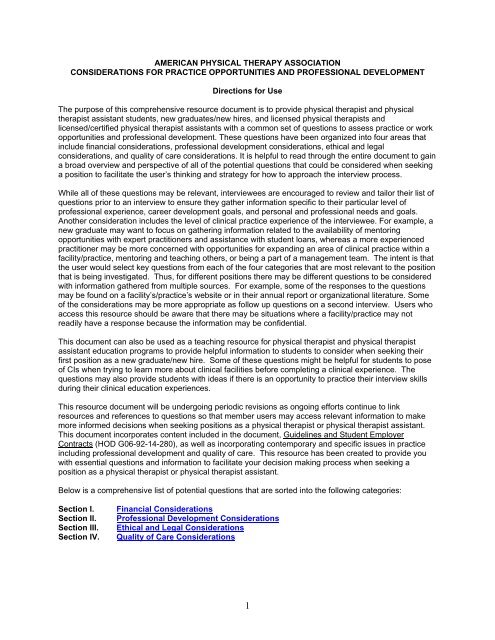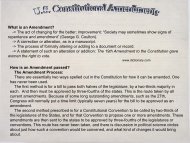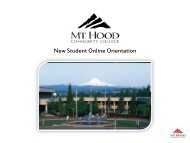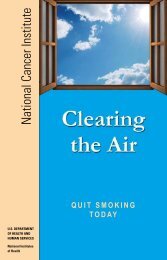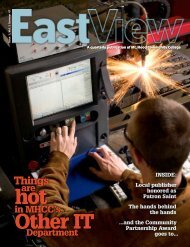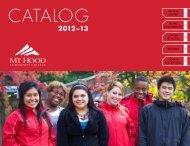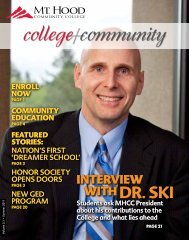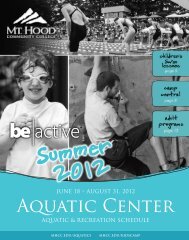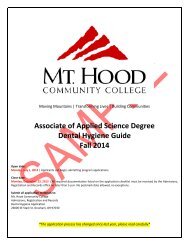Guidelines and Student Employer Contract
Guidelines and Student Employer Contract
Guidelines and Student Employer Contract
You also want an ePaper? Increase the reach of your titles
YUMPU automatically turns print PDFs into web optimized ePapers that Google loves.
3. What are the limits of liability <strong>and</strong> are those limits separate or shared?4. Is there a liability indemnification clause?5. Is the PT/PTA required to carry individual malpractice insurance in addition to what thefacility/practice policy may cover?G. What are the terms of the contractual relationship <strong>and</strong> termination options?1. Is there an opportunity for the PT’s/PTA’s attorney to review the contract?2. Is there a non-compete clause that limits the geographic area where the PT/PTA can provideservices if the contract is terminated by the PT/PTA?H. What are the financial considerations for a new graduate/new hire?1. Are there any contractual arrangements for the graduate/new hire? If yes…a. What are the specific terms?b. Is there a termination option?c. Is there a penalty or payback requirement if the new graduate/new hire leavesbefore the contract is completed?e. Does the new graduate/new hire owe the entire contract amount or is theremaining balance prorated in the event that he or she leaves prior to thecompletion of the contract?f. In the case where a contract is negotiated prior to the student graduating, whatwill happen if the student fails to graduate?g. Will there be any repercussions relative to references for future jobs if the newgraduate/new hire leaves before the terms of the contract expire?h. Is there a buy-out clause?i. Is there a non-compete clause?j. What are the tax implications, if any, associated with the contractualarrangement?2. Is assistance offered to manage education-related debt?a. Is any assistance offered to defray costs associated with student loans?b. Are there student loan forgiveness opportunities?c. Is there an employment obligation <strong>and</strong> for how long?d. What will happen to a student loan when he or she graduates, if the newgraduate’s/new hire’s student loan is assumed by the facility/practice?3. What will happen if a new graduate/new hire fails to qualify for a license?Section II.Professional Development ConsiderationsA. Is professional development valued?1. If so, how are incentives provided?Professional Development ResourcesProfessional Development DefinitionB. Is there a formal orientation process for new staff members?1. Is there an employee policy manual?2. How is a patient caseload determined?3. When is the graduate/new hire expected to accept a full case-load?4. Are new staff members supervised by a PT?5. Is CPR, AED, or other certifications (eg, ACLS, NCSA, etc) required?6. Are there other certifications that are encouraged?7. Is the orientation competency based?C. Does the evaluation of clinical advancement, career path development, competencies, <strong>and</strong>professional contributions include consideration of: 13
1. Patient satisfaction?2. Self-initiated education?a. Will there be opportunities to obtain certifications?b. Does patient management allow for PTs to advance PTA skills in interventionsthat are within the scope of work of the PTA?3. Dissemination of clinical information (e.g. rounds, case presentations, journal clubs)?4. Improvement of clinical outcomes (1) <strong>and</strong> efficiency?5. Evidence-based practice?a. Will there be opportunities to access <strong>and</strong> utilize resources to enhance patientcare during patient care hours?b. Will there be professional development resources – ie, clinic resources, library,Internet access, <strong>and</strong> full text articles?6. Serving as a mentor, consultant, <strong>and</strong> clinical instructor to students <strong>and</strong> recent graduates?7. Ability to work in an interprofessional context with other health professionals?a. Are there physicians <strong>and</strong> other health care professionals on staff?b. Is there a mechanism for referral to other disciplines, if indicated?c. What other health care providers are either involved in or involved with thefacility/practice?d. Are other professionals utilized to provide patient care (eg, athletic trainers,massage therapists, exercise physiologists, etc)?e. Is there a strong network of providers that interact <strong>and</strong> work with the PTs <strong>and</strong>PTAs?8. Leadership role in facility/practice management <strong>and</strong> practice?a. Is there an opportunity for shared leadership models? 19. Activities associated with maintaining continued competence?Licensure InformationD. Is there a process for mentorship?1. How are mentors selected or assigned?2. Are there available, accessible <strong>and</strong> experienced PTs <strong>and</strong> PTAs (as appropriate) to answerquestions <strong>and</strong> provide mentorship?a. If yes, what are their credentials <strong>and</strong> experiences?b. How many Board Certified Clinical Specialists are available to providementorship?c. How does the facility/practice support <strong>and</strong> reward attainment of Board CertifiedClinical Specialist status?3. Is there co-treatment with experienced clinicians or clinical specialists?4. How often are meetings scheduled with one’s supervisor for feedback?E. Are staff PTs <strong>and</strong> PTAs members of the APTA?1. If I want to become involved in APTA activities, how flexible is the practice environment toaccommodate these activities?2. How is time required to fulfill these activities addressed by the practice facility?3. Is staff involved in APTA activities?a. If yes, how is staff involved in Association <strong>and</strong> profession activities?F. Are there opportunities to enhance learning through…1. Regularly scheduled in-services?2. Continuing education programs with costs either fully or partially covered by thefacility/practice?a. On average, how often do staff attend CEU courses?3. Time off to attend continuing education courses?4. PT/PTA team interaction in providing patient management?5. Co-treatment with experienced clinicians or clinical specialists?G. Are there opportunities to assist with student clinical education through…4
1. An active <strong>and</strong> ongoing student education program at the facility/practice?2. A volunteer program or through an ability to take part-time <strong>and</strong>/or full-time PT or PTAstudents?3. An opportunity to teach at a local PT or PTA program?4. An opportunity to provide in-services to nursing or other professions regarding physicaltherapy with or without productivity implications?5. An opportunity for clinical instructor training <strong>and</strong> credentialing?a. How many staff have earned the APTA Clinical Instructor Credential?b. How many staff have earned the Advanced Clinical Instructor Credential?H. Are there opportunities to exp<strong>and</strong> physical therapy programs <strong>and</strong> services?1. What are the current available programs <strong>and</strong> services?2. What are the conditions under which program expansion could be considered?3. What are the conditions for which new services or specialty area of practice could beconsidered?I. Are there opportunities to conduct research <strong>and</strong> publish the results in the facility/practice?1. Who oversees <strong>and</strong> manages research conducted at the facility/practice <strong>and</strong> publication of theresults?2. Are there opportunities to collect data as a part of research conducted outside of thefacility/practice?3. Does the facility/practice have an institutional review board that oversees the integrity ofclinical research?4. Is there assistance <strong>and</strong> guidance provided in writing proposals for external funding?Section III.Ethical <strong>and</strong> Legal ConsiderationsA. What business practices are used by the facility/practice?1. How are billable services determined?2. What resources are used for billing?3. Is there access to claims billed for services if the PT/PTA requests to view those claims?4. What is the responsibility of the PT/PTA for denied claims?5. What is the facility's/practice’s payment mix for reimbursement (eg, payer mix, cash,combination thereof)?6. Related to billing <strong>and</strong> productivity, what is the ratio of PT to PTA <strong>and</strong> to other supportpersonnel?7. Does the facility/practice use business metrics (eg, ratios, productivity st<strong>and</strong>ards)?a. If yes, how?8. Is compensation based on the value of services <strong>and</strong> production (such as payment methods,productivity st<strong>and</strong>ards, etc)?Ethics in Physical Therapy – Volumes 1 <strong>and</strong> 2Law & Liability – Volume 1Law & Liability – Volume 2Ethics <strong>and</strong> Legal IssuesLegal ResourcesB. Do PTs have control over all clinical decisions related to physical therapy?1. Are patients permitted direct access to physical therapy services?2. How are referrals provided to the facility/practice?3. Do PTs have a provider number?C. How are PTAs, aides, <strong>and</strong> other support staff utilized in this facility/practice?1. How is the daily supervision <strong>and</strong> direction of the PTA conducted?2. How is the PT supervisor of record determined for the PTA?3. How does the PT/PTA team function in this facility/practice?5
4. How is the daily supervision of aides <strong>and</strong> other support staff provided?5. What are the responsibilities of the aides <strong>and</strong> other support staff?D. Do business relationships of the facility/practice avoid all potential conflicts of interest (eg,personal financial interests)?1. Is compensation (i.e. salaries, particularly those in a position to refer) based on fair marketvalue?2. Is compensation based on the volume or value of referrals?3. Is rental space <strong>and</strong> equipment leased or purchased at fair market value?Business Skills in Physical Therapy – Legal IssuesSection IV.Quality of Care ConsiderationsA. What are the PT’s/PTA’s responsibilities in the facility/practice?1. How many PTs <strong>and</strong> PTAs provide services at this facility/practice?2. How many administrative personnel work in this facility/practice?3. What is the average length of experience of the professional staff?4. What is the frequency of staff turnover?5. What were the reasons for the last few staff leaving?6. Is there an opportunity to meet with <strong>and</strong>/or observe PTs <strong>and</strong> PTAs in this facility/practice as apart of the interview process?7. What is the typical PT to PTA ratio?8. What is the typical caseload for the PT <strong>and</strong> PTA in this facility/practice?B. How does the facility/practice recognize the value of PTs <strong>and</strong> PTAs on clinical care quality <strong>and</strong>patient outcomes? 11. How are PTs <strong>and</strong> PTAs held accountable for quality care?a. Does the PT perform the patient’s/client’s examination/evaluation?b. How much time is available for patient/client examination/evaluation <strong>and</strong>treatment per visit?c. Does the physical therapist explain the patient’s/client’s plan of care <strong>and</strong> goals?d. Are concerns, treatment including functional goals addressed during the time thepatient/clients spend with the physical therapist?e. What clinical information system is used to document patient/client care?f. Do PTs <strong>and</strong> PTAs feel that their practice is supported by up-to-date clinical caretechnology? 1g. What are the documentation policies <strong>and</strong> procedures?i. What is the format for documentation?ii. Is the patient/client management model used in providing <strong>and</strong>documenting care?iii. Is there electronic documentation? If yes, what system?h. Are patient/client privacy <strong>and</strong> confidentiality maintained?i. Are there outcome assessments/quality improvement measures for st<strong>and</strong>ardizedsystematic assessment of outcomes?i. If so, how are staff involved in this process?ii. How do physical therapists measure patient outcomes?iii. How does the facility/practice monitor patient satisfaction?iv. Are there internal peer review <strong>and</strong> chart review mechanisms?2. Do PTs <strong>and</strong> PTAs provide input into policy development <strong>and</strong> operational management ofissues related to quality of care, continuity of care, <strong>and</strong> patient-staff ratios? 1a. When are related patient care activities beyond case management (direct care)completed (eg, documentation, time to seek evidence, etc)?b. Is there access to the Internet to seek <strong>and</strong> review evidence?6
c. Are patient/clients assigned to one therapist or PT/PTA team or are they seen by“whoever is available”?d. Are professional <strong>and</strong> education credentials for the PT <strong>and</strong> PTA recognized bytitles on an identification badge? 1e. Are PT <strong>and</strong> PTA licenses/certificates posted in a visible location?f. What is the PT <strong>and</strong> PTA staff-to-patient ratio?g. Does the facility/practice’s written philosophy <strong>and</strong> mission statement reflect anemphasis on quality, safety, interprofessional collaboration, continuity of care,<strong>and</strong> professional accountability?3. Is there a risk management <strong>and</strong>/or quality assurance program in place?a. Does the facility have a risk manager?b. Is there a safety committee or other st<strong>and</strong>ing body that addresses quality of care<strong>and</strong> patient/client <strong>and</strong> personnel safety issues?c. Does the facility/practice have established safety-related policies <strong>and</strong>procedures?d. Does the facility/practice comply with state <strong>and</strong> federal regulations?e. Does the practice support other activities such as community service, teaching,marketing new programs, clinical research, etc?f. Is the facility accredited by the relevant agency (ie, JCAHO, CARF, etc)?g. If so, what are the facility’s accreditation scores, if applicable?Risk Management ResourcesRisk Management PublicationsC. Does the facility/practice follow the positions, st<strong>and</strong>ards, guidelines, policies, <strong>and</strong> procedures ofthe APTA regarding clinical practice?1. PROVISION OF PHYSICAL THERAPY INTERVENTIONS AND RELATED TASKS HODP06-00-17-282. PROCEDURAL INTERVENTIONS EXCLUSIVELY PERFORMED BY PHYSICALTHERAPISTS HOD P06-00-30-363. DIRECTION AND SUPERVISION OF THE PHYSICAL THERAPIST ASSISTANT HOD P06-05-18-264. PROFESSIONALISM IN PHYSICAL THERAPY: CORE VALUES BOD 05-04-02-035. CODE OF ETHICS HOD S06-00-12-236. GUIDE FOR PROFESSIONAL CONDUCT7. STANDARDS OF ETHICAL CONDUCT FOR THE PHYSICAL THERAPIST ASSISTANTHOD S06-00-13-248. THE GUIDE FOR CONDUCT OF THE PHYSICAL THERAPIST ASSISTANT9. STANDARDS OF PRACTICE FOR PHYSICAL THERAPY HOD S06-03-09-10 <strong>and</strong> theCriteria1 Adapted with permission from the American Association of Colleges of Nursing. Hallmarks of theProfessional Nursing Practice Setting: What Every Nursing School Graduate Should Consider WhenSeeking Employment. 2004. Accessed from www.aacn.nche.edu/PNN/hallmarksbrochure.htmon January 11, 2007.Copyright © 2007 by the American Physical Therapy Association. All rights reserved.7


